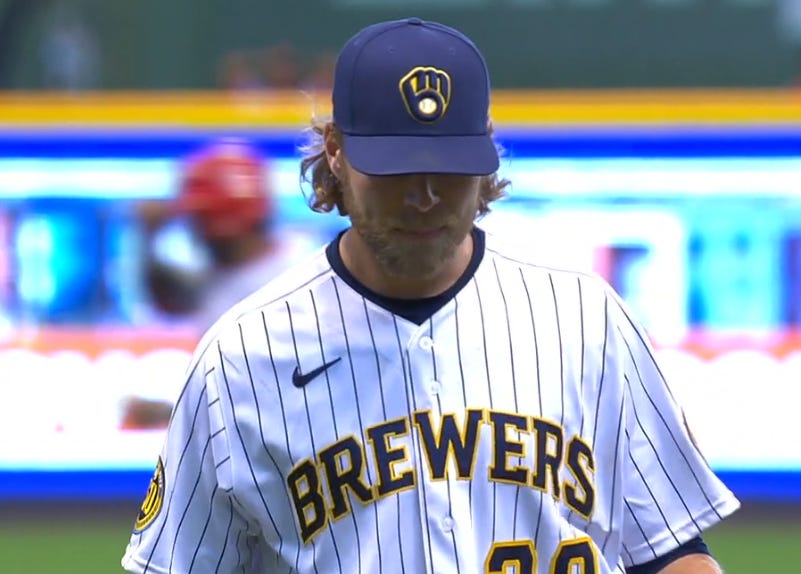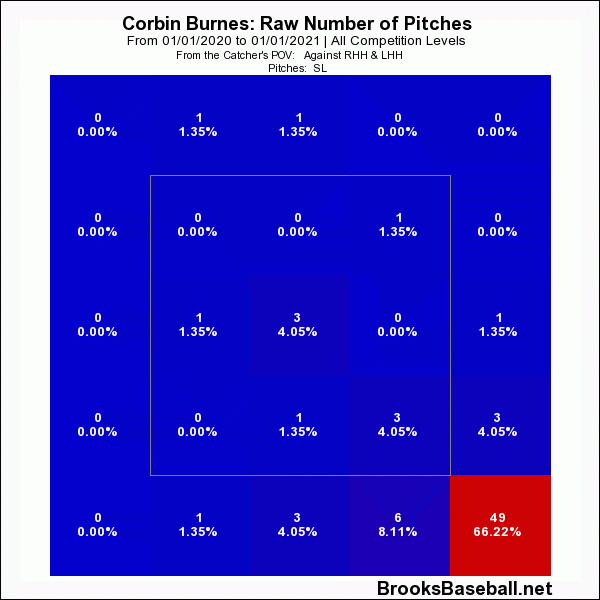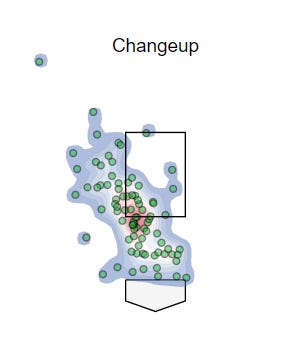There is no shortage of hype for Corbin Burnes and Byron Buxton in this newsletter.
Plus, a goodbye to Bert Blyleven, who retired from the airwaves last week.

Rich People Conversations is (we think) the world’s only Brewers-and-Twins newsletter. Written by three friends who spend far too much time watching MLB.tv, it takes a look at the quirky side of baseball while also delivering plenty of analysis and #takes. You can subscribe—for free—below.
Guys. Corbin Burnes.
~Curt

The beginning of Corbin Burnes’ career has been volatile, to say the least. There’s been the early-career bullpen dominance, followed by the abject disaster that was 2019 in which he was arguably the worst pitcher in baseball. Now, about one year after being sent down to the Brewers’ pitching lab in Arizona, the young right-hander looks like a complete pitcher.
And not just a complete pitcher, but one who has the chance to be dominant, as well.
Through his first eight appearances of the 2020 season, Burnes has been incredible. The peripheral numbers—34.4 K%, 22.1 K-BB%, 2.36 FIP, .158 average against, one homer allowed—match his output of a 2.35 ERA.
Burnes is one of only two pitchers in Fangraphs’ top 40 hurlers by WAR this season with fewer than 40 innings pitched (38.1), and, through Saturday, he’s tied for 10th in all of baseball in fWAR (1.4), ahead of names like Trevor Bauer, Sonny Gray, Hyun-Jin Ryu, Aaron Nola and Max Scherzer. Not bad!
Unlike each of those names, though, Burnes still has to prove that he can sustain this type of excellence over more than just a two-month stretch. But there are signs that show promise that Burnes’ breakout (v. 2) could be for real.
Breaking it down to build it back up
No, this isn’t about the Linkin Park song, although, nine out of 10 would consider it a #banger.
Burnes has ripped apart much of the arsenal that led to his 8.82 ERA and 6.09 FIP in 49 innings last year.
He’s gone from being a five-pitch pitcher last year that effectively functioned as a two-pitch guy who sometimes spun a curveball, change or sinker up there to being a six-pitch guy who really specializes with five plus-pitches.

Burnes’ dominant offering has always been his slider (more on this dandy of a pitch later), but, as does almost any pitcher, has had to rely largely on fastballs. For Burnes, this has never been a problem in theory because his heater has an excellent spin rate.
The problem that Burnes ran into time and time again in 2019 was that he pounded the zone with his fastball, often mid-thigh or lower, and it was crushed. Fangraphs rated the four-seam as worth -18.7 runs last year, which is unfathomably bad. He didn’t use much of the two-seam and didn’t have a cutter.
Now, Burnes has essentially scrapped the four-seam, played up the sinker and added a cutter that has been nothing short of devastating. He’s using those latter two pitches to set the table for everything else, throwing the four-seam less than 10 percent of the time in five of his last six outings.
The sinker has top-end velocity relative to other sinkers in the big leagues (96.2 mph average is top 10 percent) and it gets elite vertical movement.
That hasn’t been his best of the two primary fastball deliverings, either.
The cutter (93.2 mph) is in the 97th percentile in velocity, 77th in slugging against (.270) and gets a whiff on 29.5 percent of swings along with a 52.7 percent ground ball rate.
It’s a pitch that he’s using primarily against left-handers, and the league simply hasn’t caught up to it yet. Burnes has thrown the cut 34.2 percent of the time in two-strike counts to lefties. He’s thrown it 56 times in those situations with 17 strikeouts, allowing just one hit and only five balls in play. He can both backdoor the pitch and bury it right at the batter’s back foot.
On all fastballs, Burnes’ exit velocity against is down to 90.8 mph from and the xwOBA is down from .517 to .467 this year. They have been good pitches on their own that, just as importantly, have set up dominant secondary offerings.
The ‘other’ stuff

One of the graph lines above says it all: opponents have a .000 slugging percentage against Burnes’ slider.
Of the 70 sliders he has thrown this year, 26 have been swinging or called strikes. Five have been put into play. None have gone for a hit. And oh my gosh look at this zone profile of every slider thrown this year.

I mean....
The slider wasn’t pairing well with his four-seam last year, it goes excellently with the sinker, in particular, because of their inverse spin patterns.
Add in a changeup that, again, is thrown primarily against lefties, has the zone distribution below and has been excellent at inducing grounders, and you’ve got yourself a very good four-pitch mix.

Throw in Burnes’ curve, to which he has improved his spin rate, that has above-average horizontal movement and has yet to be hit for a fly ball or line drive in 62 offerings this year, and you have yourself a legitimate five-pitch mix of all effective pitches.
That’s a repertoire for success.
Byron Buxton is happening
~Tom
Byron Buxton and I are the same age.
Well, he’s actually five months older than me, a fact that gave me peace when he was drafted second overall in 2012 and I was still struggling to master the art of slicing avocados as a sandwich artist at Panera Bread.
So, why do I feel like a proud father watching Buxton excel on the field? Ok, that’s a weird way to put it. I think it’s more like I’ve been an investor in a small business for the last eight years, and that small business -- one that I’ve believed in since Day 1 -- can steal bases and play center field better than anyone else.
For Buxton stans like myself, it’s been a fun week of Twins baseball. On Sept. 1, we watched Buxton rob Edwin Encarnacion of a homer and then knock in the game-winning run in the seventh inning of an important 3-2 win. On Friday, Buxton beat out a routine two-hopper to third base for a scrappy hit. And the next night, Buxton was the walk-off hero in the bottom of the ninth, sprinting to first base with a speed of 31.0 feet per second to beat a throw from Detroit shortstop Willi Castro.
For reference, the MLB average is 27.0 ft/sec. Usain Bolt, the fastest man in the world among those of us who don’t inject ourselves with Compound V, sprints at a speed of 33.0 ft/sec.
Sweet biscuits.

But, oh, Buxton wasn’t done.
Just as I sat down to hammer out some Labor Day words and titled this piece “Byron Buxton: Savior of the Twins’ season,” he turned a ground ball off the pitcher’s glove into a ridiculous stand-up double.

Two innings later, Buxton pummeled an 0-1 pitch into the Cinnamon Toast Crunch cutouts in left-center field.
The man is en fuego.
Growing up in the Twins farm system, Buxton and Miguel Sano were advertised as the saviors of the franchise. Buxton was promised to be the next Mike Trout. Sano was billed to be the second coming of the Colossus of Clout. Neither of those two players have lived up to those expectations, much to the displeasure of an often disgruntled fan base.
Look, I get the frustration with Buxton. His lengthy struggles at the plate paired with his tendency to crash comic-book style into outfield walls has developed into the all-too-familiar storyline of a Bust with a capital B. The man hasn’t played more than 87 games in a season since 2017, which is the only campaign he’s appeared in over 57% of the Twins’ contests since debuting in 2015.
Minnesota sports fans have been burned so many times on future face-of-the-franchise guys, be it Christian Ponder or Andrew “Glen gave me a max deal after I gave him my word” Wiggins. No one handed the ball off like Ponder, though. You’ve gotta give him that.
But you know what Ponder or Wiggins never did? They never were responsible for sustained momentum on a team throughout a season.
Wiggy would put up 40 points and knock down a buzzer-beater (probably against Oklahoma City) one night but then shoot 2-for-14 the next. Ponder threw for two touchdowns and ran for another in a 2012 win over San Francisco, a performance that made one member of this newsletter (ok, it was me) spend $34.99 on a Ponder shirsey at Kohl’s. The following week, Ponder threw for just 111 yards and no scores. A tale as old as time.
Buxton, though, has shown again and again that he’s capable of carrying the load. In the second half of 2017, Buxton slashed .300/.347/.546 with 11 homers and 13 stolen bases. Buxton led all of baseball in doubles over the first two months of last season.
It’s there, guys.
And even better? It’s here. Right now. Just in time for the postseason.
The ever-circling—and ever circled—Bert Blyleven
~Jake
Bert Blyleven, the circling Hall of Famer and broadcaster, retired from the airwaves last Wednesday, ending an unforgettable 25-year career in the booth.
If you want a good, objective remembrance of the Dutchman’s time on the mic, the guys over at Puckett’s Pond have that. That’s not what this is. This is how I, and likely many people my age,will remember Bert.
See, Bert wasn’t ever a player to me. He was a former player, yes, and one of the better pitchers to wear a Twins uniform, but his playing career was over long before I was born. (This is probably when the readers over 30 will stop reading...see you next week!). I met him on TV before I could hop on Baseball Reference and see his stats, so I only went off what he said during the broadcasts. Though many folks from outside Minnesota may remember Blyleven for his impassioned Hall of Fame campaign, he actually was often self-deprecating. He was the first to point out his proclivity for giving up the long ball (50 in 1986!!! 430 in his career!!) or mention his losses (250). As a kid, I just assumed Blyleven was basically a Brad Radke of the 1970s and ‘80s.
It wasn’t until even after his delayed Hall of Fame induction that I realized the quality of player Blyleven was. He was worth 96.1 career WAR, according to Baseball-Reference, good for 12th all-time among pitchers. That’s, uh, notably better than Brad Radke. He was a strikeout guy (at least compared to the era) and had one of the better curveballs since baseball became televised. And just like his broadcast career, he was always around.
After 22 years as a player, Blyleven spent 26 years in the booth with Dick Bremer, creating an iconic duo that anchored my childhood. Their back-and-forth banter was the soundtrack of every summer at my house.
I guess I never questioned whether he was good or not. It didn’t even cross my mind until I started getting MLB.TV around 2015 and began listening to other broadcasters. Before then, Dick Bremer did play-by-play stuff and Bert did Bert stuff. He circled fans, he made some jokes, he talked about “downward planes” and we called it a day.
Some Twins fans have pointed out his overreliance on the media guide; he certainly wasn’t ever an advanced analytics guy and I wouldn’t say I ever learned much about baseball from him. And now we find out the whole downward plane thing was just a joke.
But all of that’s OK. Little 10-year-old Jake didn’t need a deep look into spin rate or wOBA. The downward plane was fine with me. I just wanted a broadcaster that could make me laugh with silly jokes and tell me about how pitchers were the best athlete on the field. I wanted to see him circle people and please God circle me whenever I made it to the Metrodome.
It was shtick, sure, but it was shtick we were all in on. Nobody pretended like Blyleven was giving real eye-opening analysis when a pitcher fielded a bunt, even Bert knew that. And yet, much like his playing career, Blyleven somehow became underrated. There are other broadcasters who teach me more about hitting in one breakdown than I learned in 20+ years of Bert (I love you so much, Justin Morneau), and others talk about pitch sequencing in truly interesting ways I haven’t heard before, but I don’t know if any of them carry that fun-loving camaraderie that Blyleven exuded. He was genuinely fun. Sometimes in a Dad-joke kind of way or in a childish sort of way, but it was always entertaining.
His partnership with Dick Bremer often seemed like genuine friendship, which matters over the course of thousands of three-hour-plus games. A broadcast booth with little camaraderie is like spending a semester in school with your enemy as your desk buddy.
(watch this whole clip for nostalgia purposes, but at the very least start it at 1:50.)
Blyleven could be a livewire at times--may we never forget the time he dropped the ol’ effenheimer multiple times on live TV. That only made him more intriguing.
(Couple of things: 1. This is NSFW unless you work from home, in which case blast this puppy loud. 2. Remember the channel My29? Lol.)
Towards the end of his run, we got a few more “Back in my day” type moments, but he paired that with self-deprecation and humor. Jack Morris could learn something.
I won’t pretend Blyleven was a Hall of Fame-level broadcaster like Dick Bremer (if he retires before I die, I swear I’ll write 3,000 words about that man). If Morneau eventually becomes the main guy next to Dick, the broadcasts may even be better than ever before. But I’ll sure miss those days. I’ll miss Bert.




